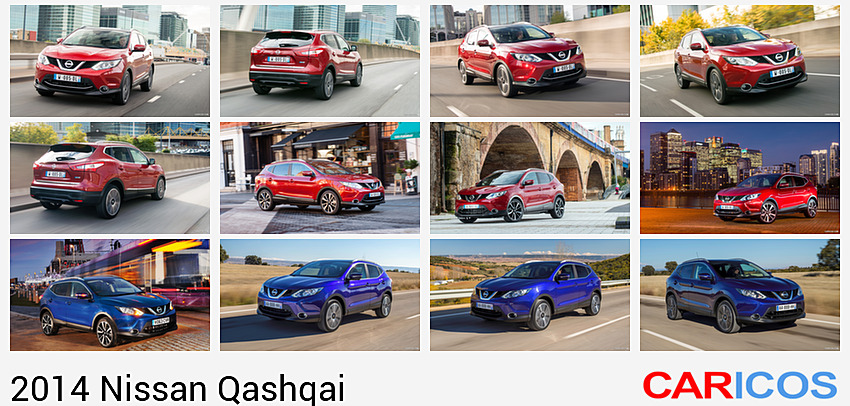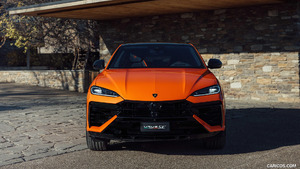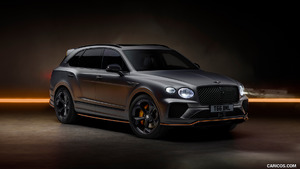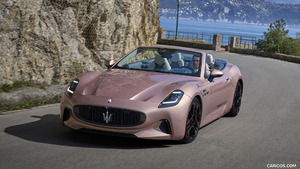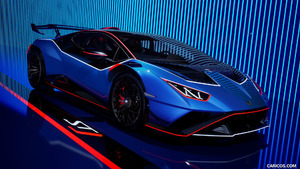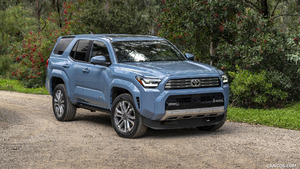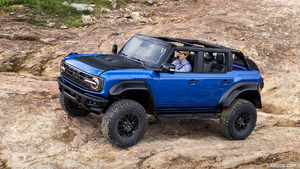2014 Qashqai
Today marks the most significant milestone in the crossover segment for seven years. In 2007, Nissan launched a model that became the crossover pioneer, found more than 2.0 million customers and was soon followed by scores of imitators. Today, that model is reinvented.
With Nissan’s trademark innovation and excitement at its core, the new Qashqai has been unveiled during a thrilling 3D social media digital mapping show in London, UK, signalling the start of the second generation of crossovers. Representing a small yet significant sample of Qashqai drivers from across the world, more than 2,500 people submitted images representing the best of technology innovation. These images then came together to form the shape of the all-new Qashqai, revealing its design to the world for the first time today.
NEW QASHQAI IN BRIEF
Nissan’s Qashqai is long established as the leader in the crossover market, with more than 2.0 million produced since 2007. It appeals to both C-segment drivers looking for additional style, technology and excitement as well as downsizing buyers seeking greater efficiency. The all-new Qashqai is set to enhance Nissan’s crossover leadership position when it goes on sale in selected global markets from January 2014.
Premium technology, second generation crossover design and enhanced dynamics all combine to form the backbone of the new Nissan Qashqai.
The striking new Qashqai is 49mm longer than the current model and fractionally lower and wider, giving it a sleek, poised stance while maintaining the crossover style, compact dimensions and raised driving position. Distinctive features - including a clamshell-style bonnet - lend a premium appearance while retaining the Qashqai’s strong visual DNA.
As with any new Nissan, the Qashqai is packed full of innovative technology. It offers drivers a comprehensive suite of advanced technology features enhancing every aspect of driving. Nissan’s Safety Shield technologies now incorporate Front Collision Avoidance, Driver Attention Support and Traffic Sign Recognition along with several other vital driver aids, while Intelligent Park Assist takes the stress out of urban manoeuvres. The new Qashqai is designed to make premium technology more accessible than ever.
The innovation continues with the new Qashqai’s powertrain range, which is wider and more efficient than ever. Every engine uses a turbocharger to reduce capacity, emissions and fuel consumption while maintaining excellent performance with class-leading CO2 emissions - from only 99g/km. Efficiency is further enhanced by an extensive mass reduction programme, resulting in 40kg weight loss on some models despite the extensive addition of new equipment.
While front-wheel-drive variants will account for the majority of sales in most markets, four-wheeldrive ALL-MODE 4x4-i versions will also be available to match a choice of six-speed manual or all-new Xtronic transmissions.
Inside, a dramatic rise in material and design quality adds significant interior appeal to the Qashqai package. Versatility also remains a core crossover attribute; Nissan’s engineers have devised innovative ways to make the new Qashqai fit into drivers’ lives. Delivering greater occupant space and a larger luggage capacity enhanced by a variable floor system, the new Qashqai even offers space to store the parcel shelf when not in use.
The new Qashqai is based on the new CMF (Common Module Family) Renault-Nissan Alliance platform, bringing outstanding engineering efficiencies to the consumer.
Designed and engineered in Europe, for Europe, the new Qashqai has been created by Nissan’s experts at Nissan Design Europe (London, UK) and Nissan Technical Centre Europe (Cranfield, UK and Barcelona, Spain), and it will be built in Sunderland, UK. Extensive input has also come from Nissan’s designers and engineers in Atsugi, Japan.
TECHNOLOGY
New Qashqai technology highlights:
- Nissan Safety Shield packages comprising:
- Front Collision Avoidance
- Driver Attention Support
- Traffic Sign Recognition
- Lane Departure Warning
- Blind Spot Warning Moving Object Detection High Beam Assist Chassis Control Full LED headlamps which consume 50 per cent of the power of previous Xenon lamps Intelligent Parking Assist New NissanConnect with smartphone app integration Around View Monitor
At the heart of the new Qashqai lies accessible technology. A suite of innovations which, when combined, form a unique package of driver aids which not only significantly enhance safety and convenience, but deliver exceptional value to Nissan drivers.
Nissan Safety Shield is a collection of features designed to enhance the safety of occupants in line with Nissan’s ongoing vision towards zero accidents, a sentiment underlined by the company’s commitment to produce commercially viable autonomous vehicles by 2020.
In the new Qashqai, Safety Shield technologies include the following features:
Front Collision Avoidance
By scanning the road ahead using a built-in radar system, the Qashqai delivers three levels of assistance. First is an audible warning, alerting the driver if the gap to the car in front is closing.
Secondly, if the driver does not react, the brakes are automatically partially applied. Finally if the gap is still closing, the brakes will be applied fully to bring the car to a complete stop if necessary.
Driver Attention Support
The new Qashqai gets to know you so that it can tell when you are getting drowsy. After taking around 10 minutes to ‘learn’ your driving style, the Nissan Safety Shield will monitor driving inputs, showing a dashboard alert if steering becomes erratic, indicating the driver should take a break.
Traffic Sign Recognition
Helping new Qashqai drivers to both stay safe and within the law, speed limit signs are automatically read by the front-facing camera and displayed to the driver. This function works across Europe, regardless of national sign typography. It even recognises that some countries enforce a weather dependent lower speed limit if it’s raining, so both dry and wet weather limits are displayed to the driver.
Lane Departure Warning
A great feature for multi-lane highways, Lane Departure Warning detects if the car is starting to drift out of lane. Advanced computer programming detects even faint road markings allowing the Qashqai to determine if it is drifting out of position. If it does, and the driver has not operated the indicators, a warning is given to the driver to correct their road position.
Blind Spot Warning
Nissan's system uses the rear view Around View Monitor camera to detect vehicles in the hidden blind spot areas on both sides of the Qashqai. If a vehicle is detected in either blind spot, a discreet warning light illuminates in the glass of the door mirror. If the driver indicates to change lanes and the system detects a vehicle in the danger area, the light flashes and an audible warning is given.
Moving Object Detection
The Qashqai is available with front and rear parking sensors which deliver audible warnings to the driver when manoeuvring as well as a visual display via the Qashqai’s dashboard combimeter. On top of this functionality, the Qashqai also benefits from an enhanced version of the existing model’s Around View Monitor ‘helicopter view’ parking aid. When stationary, if something moves into the area covered by the four cameras the system will give an audible warning and highlight the area in which the moving object is detected. Mounted on the tailgate and having a fish-eye lens, the rear wide view AVM camera has a sweep of vision in excess of 180 degrees, giving it an unparalleled field of vision at the back of the car. Images from the camera are displayed on the new, larger seven-inch NissanConnect screen.
High Beam Assist
A high resolution camera combined with advanced software has led to a sophisticated automatic high and low headlight beam function for the new Qashqai. The system optimises the use of the headlamps in order to provide the maximum amount of light possible for any driving scenario.
Safety Shield is just the start of the Qashqai’s technology story. Other highlights include:
Chassis Control
Using Nissan’s very latest ride and handling know-how, Chassis Control enhances both ride and handling, learning from the development of the GT-R supercar and delivering the functionality of a Limited Slip Differential. While the Vehicle Dynamic Control system (VDC) continues to correct severe traction loss, at lower speeds with lower forces the Active Trace Control applies specific braking force to each wheel to correct the course of the Qashqai when cornering, giving a more dynamic feel without interfering with the driving experience. What’s more, when driving over undulating surfaces, Active Ride Control applies subtle braking to individual wheels to deliver flatter body control enhancing comfort for all occupants.
Intelligent Parking Assist
Automatically measuring the size of an available parallel parking space, Nissan’s Intelligent Parking Assist requires only 80cm space in addition to the length of the Qashqai to be able to automatically steer the car safely into position. All the driver has to do is follow the on-screen instructions and control forward and reverse drive. The system can also park in car park bays, with the driver benefiting from the helicopter view provided by AVM to guide them through the process.
New NissanConnect
In-keeping with new Qashqai’s appetite for innovation, the new crossover will be the first model to go on sale with the new NissanConnect system. Now with a seven-inch touchscreen, NissanConnect has evolved to offer Smartphone connectivity to keep owners in touch with the outside world wherever their journey takes them. In the future it will have access to a range of apps covering music, social networking, entertainment and travel through a large, seven-inch colour touch screen. The new NissanConnect builds upon the recently introduced Google® search and Send To Car functions, which allow drivers to plan a trip at home.
The system includes Bluetooth audio streaming and mobile phone integration as well as Aux-in and USB slots along with DAB radio.
In addition to the main NissanConnect screen, the driver also benefits from an additional display within the instrument panel. It’s one of the most advanced meter displays yet seen with a five-inch TFT colour display incorporating no fewer than 12 graphic displays accessible on rotation. Customisable to display different Qashqai body colours, the meter offers advice and warnings covering functions including average and actual speeds, fuel economy, turn-by-turn navigation instructions, audio content, traffic sign recognition, Nissan Safety Shield, Chassis Control, eco driving advice, as well as tyre pressure information and torque distribution settings in 4WD mode. Additionally, the driver can customise steering feel, lighting, auto light sensitivity, wiper and locking settings, plus drive computer contents.
DESIGN
The second-generation Qashqai sets a new benchmark for crossover design. Having defined the original crossover template in 2007, Nissan is taking the sector to a new level thanks to bold design, highly advanced engineering, intelligent technology and remarkable attention to detail.
New from the ground up, the new Qashqai is much more than just a rework of its ground-breaking predecessor. The second-generation model is 20mm wider, 49mm longer and 15mm lower than the current car. Yet despite this reduction in height, front and rear headroom levels have actually increased by 10mm and the raised driving position remains.
The new Qashqai features a striking new look with powerful curves, clean lines and intricate details including the option of 19-inch alloy wheels. Through bold new elements such as the raised bonnet line and muscular wheelarches, the new Qashqai conveys a feeling of dynamic strength.
All-LED headlamps
The Qashqai’s front end incorporates some of the most advanced technology ever offered in the crossover sector. All models feature LED daytime running lights, certain versions are equipped with even more sophisticated technology, with full LED power for both dip and main beam. In keeping with Nissan’s passion for delivering usable technology, the use of LED instead of Xenon is more than just a gimmick. The Qashqai’s LED headlamps produce a whiter, crisper light, not only using 50 per cent less power than Xenon bulbs, but also producing light closer in colour to sunlight resulting in better visibility at night. The lights also display Nissan’s unique LED lighting signature that sweeps up dramatically from the centre of the car.
Concealed technology
Integrating advanced technology can often prove a challenge for designers, but not so for the team responsible for the new Qashqai. By working closely with engineers, they were able to incorporate new technology without compromising the car’s bold design. For example, while most manufacturers are content to incorporate their radar systems into ugly assemblies mounted in the bumper or front grille openings, Nissan has been able to relocate the Qashqai’s radar behind the bumper facia to give the car a smoother look.
Advanced aerodynamics with active elements
Nissan has always believed that form must match function, and this thinking has been taken to a new level with the second-generation Qashqai. Take, for example, the car’s aerodynamic profile. Not only does the new Qashqai deliver a dynamic and bold new look, it also cuts through the air with greater efficiency than ever before thanks to a drag co-efficient of 0.32. In creating the new Qashqai, the design and engineering teams studied every surface and detail. From the elements on show (such as the roof spoiler with winglets) to those hidden away (like the unique flat floor design), the Qashqai features some of the most advanced aerodynamic features to appear on a family car. The result is reduced drag, lower CO2 emissions, improved fuel consumption and greater stability at speed.
Another innovation making its debut on the Qashqai is an Active Grille Shutter system. This intelligent technology maximises the Qashqai’s aerodynamic efficiency by closing off airflow through the radiator when not needed. The grille shutter automatically shuts at speeds over 30kph and only opens if sensors detect that the engine needs cooling. The system will be fitted as standard on diesel-engined models with manual transmissions.
Interior – reinventing the way families travel
Comfort, connectivity and control: three of the core elements that underpin the design and layout of the new Qashqai’s cabin. Like the rest of the car, the Qashqai’s interior combines innovative technologies with common sense solutions to everyday challenges. With more experience in the crossover sector than any other marque, Nissan is in a unique position to set new practicality benchmarks for the next generation of crossover.
In creating new Qashqai’s cabin, Nissan’s design and engineering teams wanted to put the driver at the heart of the action. The car’s numerous comfort, convenience and safety systems have been analysed and redesigned to give the driver easy access to all key controls. Thanks to an intuitive single interface, drivers are able to perfectly tailor the Qashqai’s functions to their needs – from switching on three-flash indicators to adjusting how early the auto headlights switch on. Each menu and display is accurately and logically shown to the driver on the new meter display located between the analogue speedometer and tachometer and controlled by steering wheel mounted switches.
Even greater practicality
Versatility is another area where the new Qashqai excels. No area of the car’s interior was overlooked in the pursuit of increased flexibility and better practicality. The boot, for example, has a luggage capacity of 430 litres with the rear seats in position – an improvement of 20 litres over the outgoing Qashqai. This puts the new Qashqai even further ahead of its C-segment rivals – with the likes of the Ford Focus and Volkswagen Golf offering significantly less luggage space.
Passengers also enjoy more space in the new Qashqai, with improved head and leg room. The overall increase in width has allowed for greater shoulder room, while a full redesign of the door apertures means that getting in and out is easier than ever before.
Load space flexibility has also been improved with a tailgate that now opens 150mm higher and includes a dual-floor system designed to provide a flexible and versatile load space. The two reversible floor panels can easily be raised or lowered providing 16 possible configurations to either maximise luggage volume or provide a full flat floor with rear seats folded. Additionally the rear board easily slots into a vertical position providing an ideal sized space for carrying shopping bags. Furthermore the load cover fits neatly under the luggage floor allowing bulky items to be loaded. The luggage boards feature a wipe-clean surface on one side and soft carpet on the other, so muddy boots can be transported without fear of damaging the textile surfaces.
All-new seats – using science to minimise fatigue
A great cabin starts with great seats, and Nissan has worked hard to ensure that the second-generation Qashqai is even more comfortable for passengers. During the design stage, engineers used advanced medical scanning techniques and were inspired by NASA to analyse pressure and blood flow in the lower back of seated passengers. By redesigning elements and improving support in key areas, they were able to create a seat that offered even support. The highly advanced new Qashqai seat offers special support thanks to additional bolsters in the pelvis, lumbar and chest areas. The result is a seat that delivers long-distance comfort.
Taking attention to detail to a new level
Like any new Nissan, the Qashqai features numerous elements that will have passengers wondering, ‘why has nobody else thought of this?’ Take, for example, the centre console. Although having a USB port in the central box is nothing new, Nissan has created a channel for the wire – allowing passengers to operate their device outside the box without having to force the lid shut. Another example of Nissan’s common sense approach to design can be found on the cupholders. By making the cavities extra deep, bottles can be accommodated without getting in the way of the driver’s arm when changing gear. The use of an electronic parking brake also frees up valuable cabin space.
Passengers in the new Qashqai also benefit from a new ambient cabin lighting system, featuring a subtle orange mood light around the gearlever. Designed to give the cabin a premium look and feel when travelling at night, the lighting system is fully controllable by the driver and can easily be turned up, down or off altogether.
ENGINES AND TRANSMISSIONS
Combining conventional passenger car efficiency with the sense of adventure of an SUV has always been a key part of the appeal of crossovers. A range of supremely efficient and refined petrol and diesel engines allows the new Qashqai to exceed the expectations of drivers no matter which powertrain is chosen.
The line-up consists of four engines: two petrol and two diesel, with the option of two- or four-wheel-drive. Customers can also choose between manual and all-new Xtronic automatic transmissions.
Petrol
1.2 DIG-T 115PS (85kW)
Nissan believes that advanced technology should be available to all customers. The 1.2-litre DIG-T is an Alliance-developed engine tuned specifically by Nissan for the new Qashqai.
Driving through a six-speed manual transmission, this advanced turbocharged engine delivers 115PS (85kW) and generates 190Nm of torque. Despite its modest size, the 1.2-litre engine packs a real punch, offering sharper acceleration and greater flexibility than the outgoing 1.6-litre naturally aspirated engine.
Its lower weight and more fuel-efficient operation also means that the entry-level petrol Qashqai is considerably cleaner and more economical than the model it replaces. The 1.2 DIG-T engine emits 129g/km of CO2 (15g/km less than the outgoing 1.6-litre petrol unit), and has a fuel consumption figure of 50.4mpg .
Like all engines in the new Qashqai range, the 1.2 DIG-T is equipped with Start/Stop ignition as standard, and benefits from a raft of fuel-saving technologies, including a regenerative alternator, optimised gear ratios and special low-viscosity oils.
1.6 DIG-T 150PS (110kW)
Set to join the Qashqai range in the autumn of 2014, the most powerful petrol engine will be the 1.6 DIG-T engine, combining sharp performance with low emissions and remarkable fuel efficiency.
Tuned specifically for the Qashqai, this acclaimed engine features advanced turbocharging technology and a raft of additional features designed to maximise performance and economy.
With 240Nm of torque on offer, the 1.6 DIG-T delivers impressive low and mid-range pull, with excellent in-gear flexibility. Yet despite its strong performance, the range-topping petrol option retains impressive efficiency. Fuel consumption is 50.4mpg on the EU combined cycle, while CO2 emissions are 132g/km.
Diesel
1.5 dCi 110PS (81kW)
The latest evolution of the award-winning direct injection diesel engine is the cleanest and most fuel-efficient engine ever offered in a Qashqai with CO2 emissions of just 99g/km. Shared with Nissan’s Alliance Partner Renault, the sixth-generation 1.5-litre dCi unit is smoother, more efficient and more refined than the outgoing engine. Thanks to a substantial re-engineering programme, the 1.5-litre dCi engine offers greater in-gear flexibility thanks to a 20Nm increase in torque.
Major changes to the engine’s internals have also resulted in quieter operation and a reduction in vibration. Removal of the upper torque rod mount has eliminated a potential noise path from the engine to the cabin, while the overall weight of the unit has been reduced with new lightweight components.
The engine also features Nissan's automatic Start/Stop system, with highly efficient smart management technology that ensures the engine restarts within 0.5 seconds of the clutch being engaged. Reduced combustion noise further enhances the unit's overall refinement.
In terms of fuel consumption, the 1.5 dCi sets new standards in the crossover sector with an EU combined figure of just 74.3mpg.
1.6 dCi 130PS (96kW)
Positioned at the top of the Qashqai’s diesel range, the 1.6 dCi is offered with the option of two and four-wheel-drive. Jointly developed with Alliance partner Renault, this 130PS (96kW) unit is one of the most advanced diesel powerplants in its sector, with a number of technical innovations designed to maximise fuel consumption and reduce CO2 emissions.
Introduced on the current Qashqai, the 1.6 dCi engine is light, compact and strikes the perfect balance between strong performance and exceptional economy. Among the unit’s many innovations is a cold-loop, low-pressure exhaust gas recirculation system. By recycling the exhaust gas at a lower temperature, emissions of nitrogen oxides and CO2 are reduced.
Thermal management of the 1.6 dCi is also much more efficient with a reduced warm-up phase, reducing friction losses and fuel consumption.
In two-wheel-drive manual form, the 1.6 dCi has CO2 emissions of 115g/km and an EU combined fuel consumption figure of 64.2mpg. The Xtronic version emits 119g/km and returns 61.4mpg, while the four-wheel-drive manual version enjoys figures of 129g/km and 57.6mpg.
New Xtronic transmission
Developed specifically for the second-generation Qashqai, the new Xtronic transmission is available with the 1.6 dCi engine.
This highly advanced transmission is based on the principle of a constantly variable transmission, but has been engineered to deliver a smoother, more natural driving experience. Unlike conventional variable transmissions, the Qashqai’s Xtronic gearbox mimics the behaviour of traditional, multi-ratio automatic gearboxes during hard acceleration, with stepped changes. In more gentle driving, the ratios are subtly adjusted to give ultimate smoothness. This means the Xtronic transmission offers the best of both worlds for drivers, with ultra-smooth low-load power delivery and direct performance during higher acceleration driving.
All figures subject to homologation
DYNAMICS
Chassis
Underneath the new Qashqai’s sleek body is a new modular platform that has been tailored specifically for the second-generation crossover. The highly advanced, Alliance-developed structure is one of the most adaptable platform systems in existence, giving designers and engineers the opportunity to perfectly tailor the car to customer needs.
The vast majority of the new Qashqai’s upper body was designed and engineered in Europe. As a result, the new Qashqai feels perfectly at home on European roads, with ride and handling standards that exceed sector expectations in every area.
In terms of suspension layout, the new Qashqai features MacPherson struts at the front and one of two different designs at the rear. Two-wheel-drive models are equipped with an advanced twist beam design, while models fitted with ALL-MODE 4x4-i feature a multi-link system. The Qashqai’s suspension system has been developed in Europe to deliver the kind of smooth and responsive driving experience Nissan customers have come to expect.
As with the rest of the car, the new Qashqai features a host of engineering innovations designed to make life easier, more comfortable and more enjoyable for drivers and passengers.
Double piston shock absorbers
Creating a car with good low-speed ride and the ability to handle rough surfaces usually involves a compromise in set-up. Not so with the new Qashqai. The second generation model is equipped with advanced double-piston shock absorbers that deliver faultless damping at both ends of the dynamic range. The two channel system features a conventional channel that handles the kind of low-frequency bumps found on rough roads, and an additional channel that deals with the kind of small high-frequency bumps found on smoother roads. The end result is a car that delivers a smooth and refined ride whatever the road surface.
Next-generation power steering
During development stages of the Qashqai, every element of the car’s dynamic package was examined to see if improvements could be made. The steering, for example, has been completely redesigned and re-engineered, with a new Electronic Power Assisted Steering (EPAS) system introduced across the range.
The system has been tuned with a new control logic that delivers a more natural driving experience, thanks in part to a five per cent reduction in overall steering ratio to improve responsiveness.
Of course, creating a great steering system is more than just fine-tuning the assistance system. To help give the Qashqai an even more natural driving experience, and improve further straight line stability, the caster trail of the front suspension has been lengthened. By creating a longer caster trail, the front wheels have a more positive self-centring action, resulting in better feel through the steering wheel.
Your steering, how you like it
Nissan knows that different drivers like different levels of steering feedback. While some prefer a light feel that requires minimal effort, others like the heavier feedback normally associated with sportier cars. To meet these unique demands, Nissan has created a two-mode steering system that drivers can switch between, depending on their mood or preference.
In Normal mode, the Qashqai offers light responses that are perfectly suited to urban driving, low-speed manoeuvring and effortless cruising. In Sport mode, the EPAS system provides more feedback to the driver and requires more steering effort to turn.
ALL-MODE 4x4-i & Chassis Control
Drivers opting for the ALL-MODE 4x4-i transmission option benefit from one of the most advanced four-wheel-drive systems on the market, which is designed to offer maximum security and traction in all conditions.
The Chassis Control system on both two and four-wheel drive versions takes vehicle dynamics one step further combining three elements.
Active Ride Control monitors the wheel speed to detect undulations which could potentially upset the pitch of the car body and applies subtle braking to compensate.
Active Engine Brake, meanwhile, harnesses the power and controllability of the Xtronic transmission to add a degree of engine braking while cornering. The benefits are greater braking control and enhanced feel with less pedal effort along with less brake application when cornering and greater braking feel when coming to a stop.
Active Trace Control monitors the behaviour and trajectory of the car, and applies subtle braking to deliver a function similar to a Limited Slip Differential, providing the best traction and the least understeer. This highly intelligent system works seamlessly with the driver, to deliver an agile and secure driving experience.
Hill Start Assist
Pulling away on an incline is no longer a stressful operation thanks to a new system developed specifically for the new Qashqai. Hill Start Assist works with the car’s ESP system to ensure a fuss-free launch. By applying the brakes to all four wheels, the car is held stationary for two to three seconds when on an incline. The brakes are released when drive is fed through to the wheels.
RANGE AND PRODUCTION
Precise specifications and trim levels will be released nearer to the new Qashqai’s on-sale date of February 2014.
Built in Europe, for Europe
The success of the original Qashqai has meant success for the European motor industry. Production of Qashqai at Nissan’s Sunderland plant in the UK has been running around the clock, with three shifts, since 2010 to keep up with demand.
Sunderland is the biggest-ever plant in the UK, producing more than 500,000 cars a year. The Qashqai is the main vehicle produced at the factory, along with the new Note, Juke crossover and the state-of the art LEAF electric vehicle.

